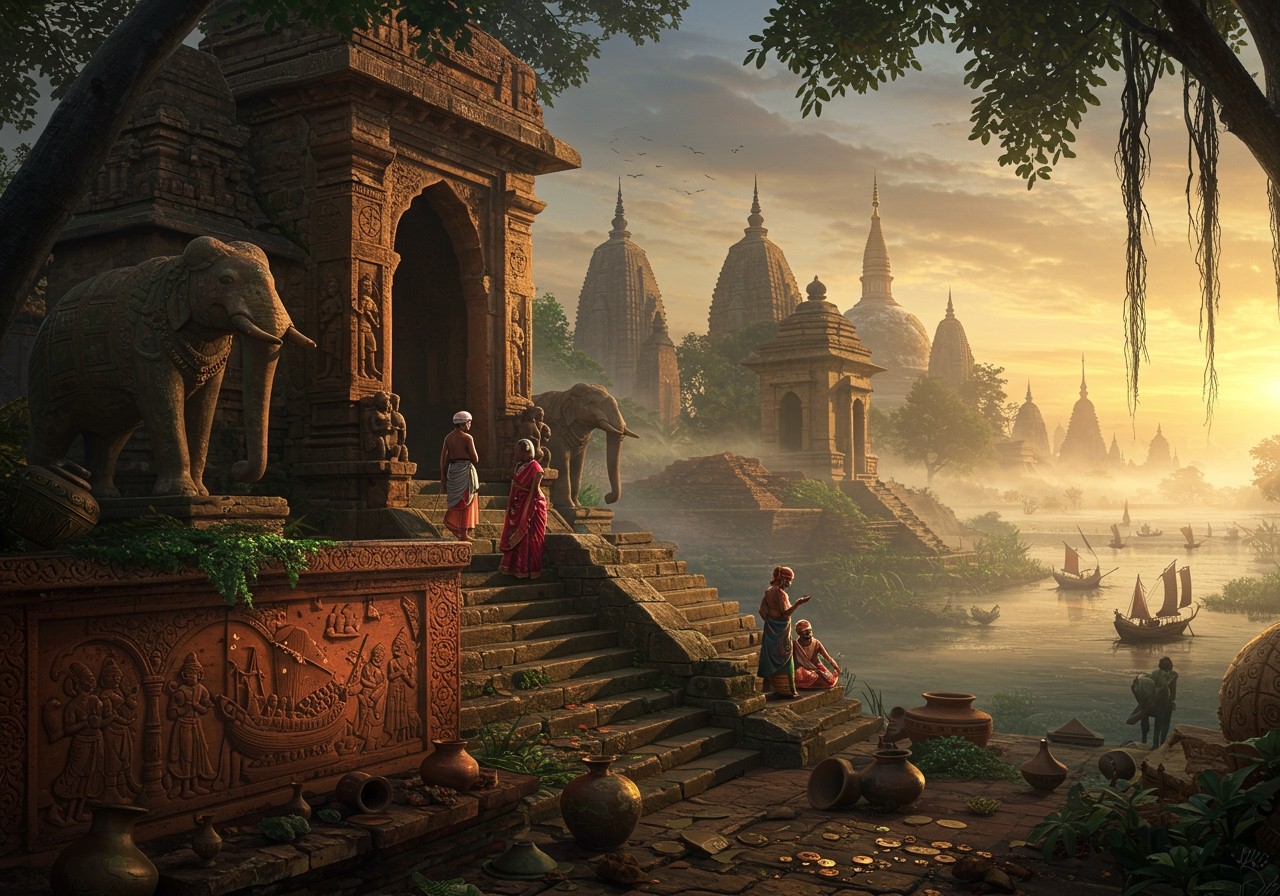
Nestled in the heart of ancient Bengal, the kingdom of Samatata whispers tales of a time long past. This blog invites you on an exploration of this captivating realm, delving into its historical significance, cultural richness, and the archaeological discoveries that continue to unveil its secrets. Join us as we uncover how Samatata contributed to the vibrant tapestry of ancient India and continues to influence modern Indian culture. Let’s embark on this enlightening journey together.
Samatata’s Place in History
Emerging in the early centuries CE, Samatata finds mention in ancient texts, including the copper plate inscriptions of the mighty Gupta Empire. The kingdom flourished as a prominent center of Buddhism, drawing scholars and monks from distant corners of Asia. Its political interactions with powerful neighbors, such as the Gupta and Pala empires, shaped the course of regional politics, commerce, and cultural exchange. This period marked a significant era of growth and influence for Samatata, laying the foundation for its lasting legacy.
Want to learn more about the rich history of ancient learning centers? Explore our blog post on Jyotisar Gurukul.
Archaeological Treasures of Samatata
The earth beneath Samatata holds a wealth of stories. Excavations have unveiled remarkable remnants of the past, including magnificent Buddhist stupas, serene viharas, and other intriguing structures. These discoveries, such as terracotta plaques, ancient coins, and intricately designed pottery, offer glimpses into the daily lives, vibrant trade practices, and deeply rooted religious beliefs of the people who once called Samatata home. Modern archaeological techniques continue to peel back the layers of time, revealing more of Samatata’s hidden past. These ongoing explorations promise even more exciting revelations in the future.
Discover the architectural wonders of ancient temples. Visit our blog on Sas Bahu Temples for a deeper dive into this fascinating subject.
Samatata in the Grand Tapestry of Ancient India
Samatata’s strategic location as a maritime hub facilitated bustling trade routes between India and Southeast Asia. This vibrant exchange of goods and ideas led to a unique fusion of Indian and Southeast Asian influences, reflected in the region’s distinctive art and architecture. Moreover, Samatata played a pivotal role in the dissemination of Buddhism and other religious practices to neighboring regions, leaving an indelible mark on their cultural landscapes. The kingdom’s influence extended far beyond its borders, enriching the tapestry of ancient India.
Samatata’s Enduring Cultural Legacy
The echoes of Samatata’s vibrant culture resonate even today in modern Bengal and Bangladesh. Its Buddhist heritage sites stand as proud testaments to its historical significance, carefully preserved by local communities who cherish their ancestral legacy. The artistic and architectural traditions of Samatata continue to inspire and shape modern Bengali aesthetics and design, demonstrating the enduring power of its cultural influence.
Samatata and the Shaping of Modern Identity
Samatata’s history plays a vital role in shaping the identity of the people who inhabit the region today. A deep sense of pride in their local heritage fuels their efforts to preserve its rich history. Educational curricula and cultural programs celebrate Samatata’s legacy, ensuring that its stories are passed down through generations. Government bodies and cultural organizations actively promote awareness and conservation of its archaeological sites, recognizing their invaluable contribution to the region’s cultural identity. Furthermore, Samatata’s historical sites hold immense potential for cultural tourism, offering opportunities for regional development and fostering a deeper connection with the past.
Delve into the legacy of the Chandela dynasty and their architectural marvels. Explore our blog on Chandela Dynasty Architecture.
Connecting with Samatata’s Spiritual Heritage through Poojn.in
Poojn.in, India’s leading provider of cultural and religious goods, empowers you to honor the spiritual heritage of ancient Samatata through a thoughtfully curated selection of authentic puja items and ritual materials. As India’s largest Dashakarma bhandar, we offer:
- Traditional Bengali puja items, carefully chosen to align with the time-honored practices of the Samatata region, allowing you to connect with your roots in a meaningful way.
- Pure copper and brass items for your rituals, reminiscent of the artifacts discovered in ancient Samatata, bringing a touch of history and authenticity to your spiritual practices.
- Authentic materials for worshipping deities revered in ancient Bengal, such as Lord Indra, helping you maintain the integrity of traditional worship.
- Complete puja sets meticulously arranged according to traditional specifications, ensuring that you have everything you need for a fulfilling and authentic puja experience.
Explore Related Products on Poojn.in:
- Copper kalash for traditional Bengali rituals
- Pure brass puja thali sets
- Clay diyas (doat) for Saraswati Puja
- Pure Kalwa (off-white Raksha Sutra)
Need assistance? Our team is here to help you select the perfect ritual items. Reach us via:
- Phone: 03369029784
- WhatsApp: 9476142738
- Website: www.poojn.in
We deliver across India, bringing the sanctity of tradition to your doorstep. Shop Now at Poojn.in.
Reflecting on Samatata’s Timeless Influence
Samatata’s story transcends the boundaries of time. It isn’t merely a historical account; it’s a living narrative woven into the cultural fabric of Bengal and Bangladesh. By understanding Samatata’s rich history and archaeological treasures, we gain a deeper appreciation for our shared heritage, connecting us to the ancient world. This knowledge inspires us to cherish and preserve these cultural legacies for generations to come. As we honor the past and embrace the future, Samatata remains a powerful symbol of enduring tradition and cultural unity.
Frequently Asked Questions About Samatata
What was Samatata? Samatata was an ancient kingdom located in the eastern part of the Indian subcontinent, specifically in present-day Bangladesh and parts of West Bengal, India. It held significant historical and cultural importance in the region, influencing its development and leaving a lasting legacy.
Why is Samatata considered important in ancient history? Samatata’s significance lies in its role as a hub for trade and cultural exchange. Strategically positioned near the Bay of Bengal, it served as a vital link between India and Southeast Asia. Its interactions with neighboring kingdoms contributed to the region’s political and cultural landscape.
What key archaeological findings have been made in Samatata? Excavations in Samatata have revealed a wealth of artifacts, including ancient coins, inscriptions, and structural remains. These discoveries offer insights into the kingdom’s economic activities, religious practices, and architectural styles. They continue to shed light on Samatata’s vibrant past.
How does Samatata connect to the broader context of ancient India? Samatata was an integral part of ancient India, engaging in trade, political alliances, and cultural exchanges with other kingdoms. Its influences extended beyond its borders, impacting the broader historical narrative of the subcontinent.


